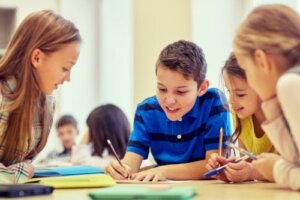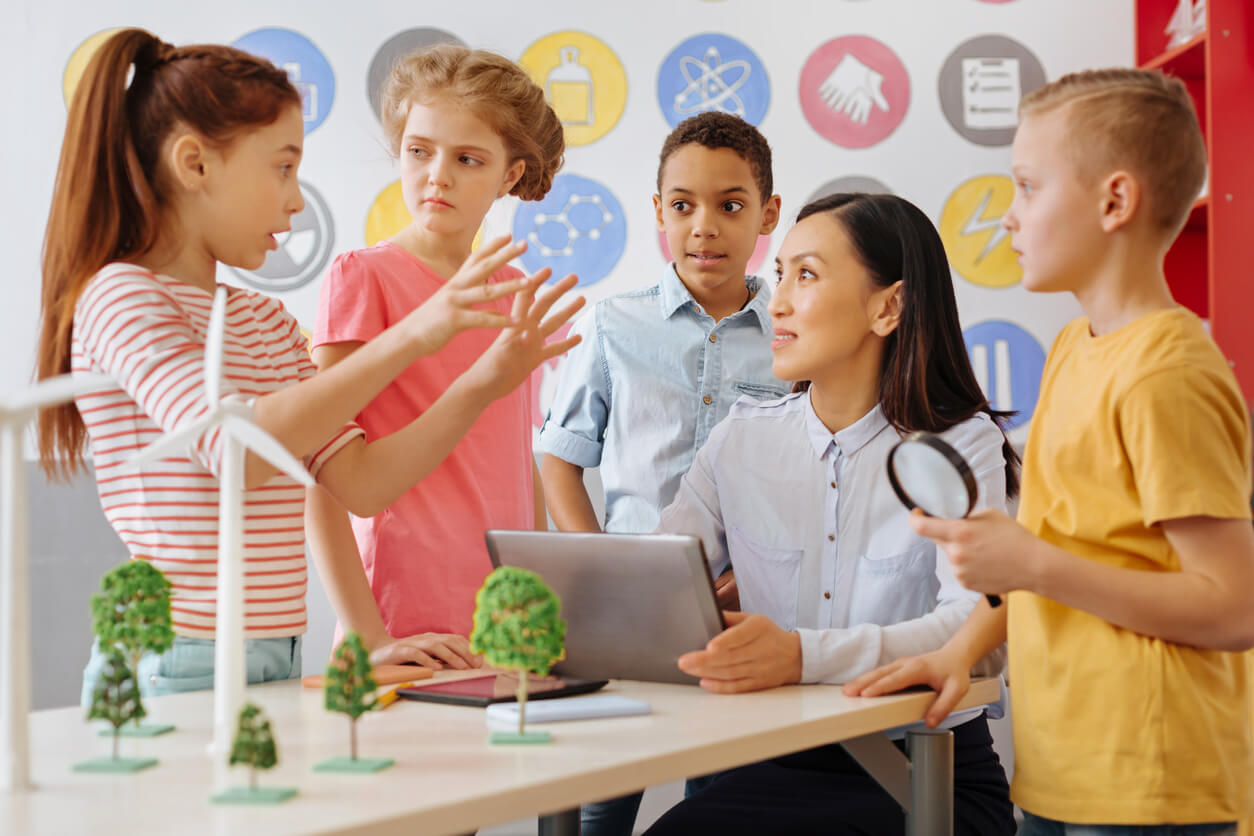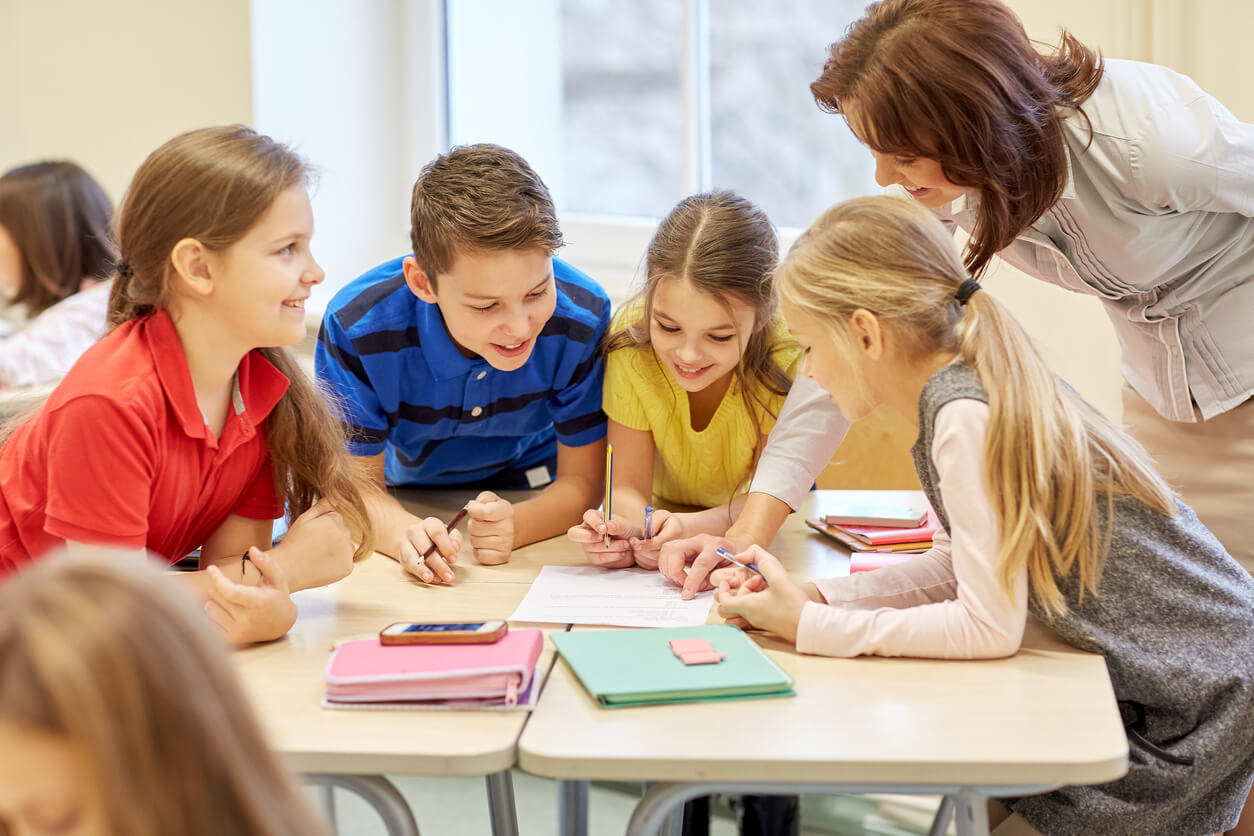5 Cooperative Learning Activities for Children


Written and verified by the teacher Samanta Ruiz
Because of its comprehensive nature, education goes beyond academic knowledge and teaches students to develop other skills and competencies that are necessary for life. To achieve this, it’s a good idea to implement in the classroom cooperative learning activities designed for children.
According to social psychologists David and Roger Johnson (1999):
“Cooperative learning is the didactic use of small, usually heterogeneous, groups in which students work together to achieve common goals while maximizing their own and each other’s learning.”
The first thing that’s needed to start working with this dynamic is to decide which topics are appropriate for this pedagogical method. The second thing is to organize the groups (from 2 to 6 members each) and then define which cooperative learning activities are best, according to the objectives and topics of your subject.
Cooperative activities for group learning
Here are some examples. Don’t miss them!
1. Knowledge Puzzles

This activity is based on the puzzle technique created by psychologist Elliot Aronson in 1971. It involves dividing the class into groups and assigning them all the same topic. In each group, there will be an expert and several non-experts.
Once organized, the following activities are carried out:
- The meeting of experts to exchange ideas.
- Experts return to the group to share the knowledge learned from the other experts.
- Presentation of findings by one of the non-experts in each group.
- Discussion and final evaluation.
The ultimate goal is to achieve a dynamic that favors children’s cooperative learning, in which everyone contributes their ideas for the construction of group knowledge.
2. Resolving academic controversies and conflicts
The creators of the concept of cooperative learning, psychologists David and Roger Johnson, proposed the term “intellectual conflict” to encourage critical thinking and instill decision-making and problem-solving.
The activity that takes place is group research on a given topic and the definition of a reasoned position.
All groups must investigate the same thing and then, in a dynamic class, each must defend their point of view, refute the other arguments, and conduct a round-table discussion to propose solutions.
One of the greatest advantages of this cooperative learning activity is that it fosters fellowship. Also, in order to learn, children must take a position and defend it with a solid foundation.
3. Cooperative literacy
Group reading is enriching and, with this activity, children learn to concentrate, pay attention, and analyze texts together.
First, pairs or groups are formed and all are assigned the same reading. One of the members reads it aloud, while the others follow along quietly.
Every one or two paragraphs, the reading is stopped and the group members summarize what they’ve heard. This is repeated several times until the proposed text is completed.
The objective is for everyone to understand what the reading is about and, through cooperative sharing, those who haven’t managed to understand can benefit from the contribution of others.
The best thing about this cooperative activity is that it can be adapted to different levels of literacy.
4. Correcting homework in pairs
For this task, pairs of students are formed and, at the beginning of the class, each one tells their partner how they solved their homework assignment.
The children compare their productions and, if possible, make the pertinent corrections. If it’s complicated, they ask the teacher to explain how to do it correctly.
5. Group research
In this type of project work, all groups are assigned the same topic to research and plan a presentation.
Each team divides the general topic into individual subtopics and then each does their own homework and research. Finally, a group presentation is made in a final report or concept map, which contains the individual contributions of all participants.

How to organize the activities?
Nowadays technology is a great ally for education and group work. Different digital tools allow you to assign and organize group tasks so that everyone has a complete overview of the overall process. Some of the most used are the following:
- Padlet: This is a collaborative whiteboard on which you can work with texts, images, and videos.
- Stormboard: These are virtual boards for recording tasks.
- Bubbl.us: Concept Mapping: This is a useful tool for constructing concept maps.
Cooperative learning is essential for group work
Education trains children to lead a future life full of jobs and social experiences of all kinds. Therefore, it’s necessary for them to acquire the skills to work in a group, whether it’s at work, with other students, in a recreational setting, or in any other kind of group.
That is the main purpose of cooperative learning activities for children: That they learn to work in a team. And the best thing about this method is that it can be applied to all ages and stages of life.
While young children can build a homemade sundial and present it as a final project, older children can investigate science topics such as the water cycle or magnetism as a group.
Working together, discussing opinions, substantiating positions, and presenting conclusions will help them work on valuable skills in order to get by in the world that awaits them outside. Encourage them to do so!
Because of its comprehensive nature, education goes beyond academic knowledge and teaches students to develop other skills and competencies that are necessary for life. To achieve this, it’s a good idea to implement in the classroom cooperative learning activities designed for children.
According to social psychologists David and Roger Johnson (1999):
“Cooperative learning is the didactic use of small, usually heterogeneous, groups in which students work together to achieve common goals while maximizing their own and each other’s learning.”
The first thing that’s needed to start working with this dynamic is to decide which topics are appropriate for this pedagogical method. The second thing is to organize the groups (from 2 to 6 members each) and then define which cooperative learning activities are best, according to the objectives and topics of your subject.
Cooperative activities for group learning
Here are some examples. Don’t miss them!
1. Knowledge Puzzles

This activity is based on the puzzle technique created by psychologist Elliot Aronson in 1971. It involves dividing the class into groups and assigning them all the same topic. In each group, there will be an expert and several non-experts.
Once organized, the following activities are carried out:
- The meeting of experts to exchange ideas.
- Experts return to the group to share the knowledge learned from the other experts.
- Presentation of findings by one of the non-experts in each group.
- Discussion and final evaluation.
The ultimate goal is to achieve a dynamic that favors children’s cooperative learning, in which everyone contributes their ideas for the construction of group knowledge.
2. Resolving academic controversies and conflicts
The creators of the concept of cooperative learning, psychologists David and Roger Johnson, proposed the term “intellectual conflict” to encourage critical thinking and instill decision-making and problem-solving.
The activity that takes place is group research on a given topic and the definition of a reasoned position.
All groups must investigate the same thing and then, in a dynamic class, each must defend their point of view, refute the other arguments, and conduct a round-table discussion to propose solutions.
One of the greatest advantages of this cooperative learning activity is that it fosters fellowship. Also, in order to learn, children must take a position and defend it with a solid foundation.
3. Cooperative literacy
Group reading is enriching and, with this activity, children learn to concentrate, pay attention, and analyze texts together.
First, pairs or groups are formed and all are assigned the same reading. One of the members reads it aloud, while the others follow along quietly.
Every one or two paragraphs, the reading is stopped and the group members summarize what they’ve heard. This is repeated several times until the proposed text is completed.
The objective is for everyone to understand what the reading is about and, through cooperative sharing, those who haven’t managed to understand can benefit from the contribution of others.
The best thing about this cooperative activity is that it can be adapted to different levels of literacy.
4. Correcting homework in pairs
For this task, pairs of students are formed and, at the beginning of the class, each one tells their partner how they solved their homework assignment.
The children compare their productions and, if possible, make the pertinent corrections. If it’s complicated, they ask the teacher to explain how to do it correctly.
5. Group research
In this type of project work, all groups are assigned the same topic to research and plan a presentation.
Each team divides the general topic into individual subtopics and then each does their own homework and research. Finally, a group presentation is made in a final report or concept map, which contains the individual contributions of all participants.

How to organize the activities?
Nowadays technology is a great ally for education and group work. Different digital tools allow you to assign and organize group tasks so that everyone has a complete overview of the overall process. Some of the most used are the following:
- Padlet: This is a collaborative whiteboard on which you can work with texts, images, and videos.
- Stormboard: These are virtual boards for recording tasks.
- Bubbl.us: Concept Mapping: This is a useful tool for constructing concept maps.
Cooperative learning is essential for group work
Education trains children to lead a future life full of jobs and social experiences of all kinds. Therefore, it’s necessary for them to acquire the skills to work in a group, whether it’s at work, with other students, in a recreational setting, or in any other kind of group.
That is the main purpose of cooperative learning activities for children: That they learn to work in a team. And the best thing about this method is that it can be applied to all ages and stages of life.
While young children can build a homemade sundial and present it as a final project, older children can investigate science topics such as the water cycle or magnetism as a group.
Working together, discussing opinions, substantiating positions, and presenting conclusions will help them work on valuable skills in order to get by in the world that awaits them outside. Encourage them to do so!
All cited sources were thoroughly reviewed by our team to ensure their quality, reliability, currency, and validity. The bibliography of this article was considered reliable and of academic or scientific accuracy.
- Consellería de cultura, educación e universidade. (s.f.) El mapa conceptual. Xunta de Galicia. https://www.edu.xunta.gal/centros/ceipgurriaran/system/files/EL+MAPA+CONCEPTUAL.pdf
- de Haro, E. F. (2010). El trabajo en equipo mediante aprendizaje cooperativo. Departamento de Psicología Evolutiva y de la Educación.
- Gobierno de Canarias (s.f.) Kit de pedagogía y kit. Consejería de Educación, Universidades, Cultura y Deportes. https://www3.gobiernodecanarias.org/medusa/ecoescuela/pedagotic/aprendizaje-cooperativo/
- Johnson, D., Johnson, R., Johnson Holubec. E. (1999) El aprendizaje cooperativo en el aula. Editorial Paidós.
- Jover González, J. (2018). PROYECTO MURAL COOPERATIVO EL ARTE COMO HERRAMIENTA DE INSERCIÓN SOCIAL (Doctoral dissertation, Universitat Politècnica de València). https://riunet.upv.es/handle/10251/97486
- Rue, J. (s.f.) ¿Qué es Aprendizaje Cooperativo? Universitat Polítécnica de Catalunya. Barcelona. https://www.upc.edu/rima/es/grupos/giac-grupo-de-interes-en-aprendizaje-cooperativo/bfque-es-aprendizaje-cooperativo
- Romero, E. (s.f.) Técnica del puzzle. Universidad de Salamanca. https://diarium.usal.es/ariasromeroelisa/innovacion-y-evaluacion/tecnica-del-puzzle/
This text is provided for informational purposes only and does not replace consultation with a professional. If in doubt, consult your specialist.








